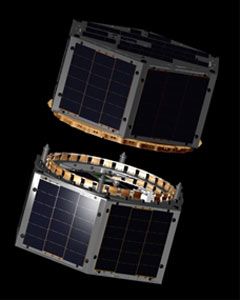
Home - Search - Browse - Alphabetic Index: 0- 1- 2- 3- 4- 5- 6- 7- 8- 9
A- B- C- D- E- F- G- H- I- J- K- L- M- N- O- P- Q- R- S- T- U- V- W- X- Y- Z
Fastrac
 USA 222 Credit: Manufacturer Image |
Status: Development ended 1996. Thrust: 269.00 kN (60,473 lbf). Specific impulse: 310 s. Height: 2.13 m (6.98 ft). Diameter: 1.22 m (4.00 ft).
Designed by NASA's Marshall Space Flight Center in Huntsville, the Fastrac was intended to demonstrate lower cost in a reusable simple turbopump rocket engine. Each Fastrac engine was initially to cost approximately $1.2 million - about one-fifth of the cost of similar engines. That price was expected to drop even more within a few years to $350,000 per engine. Fastrac incorporated drastic reductions in the cost of turbomachinery. Initially, each turbopump would cost about $300,000 - one-tenth of the average cost of then-current rocket engine turbopumps. That cost also was expected to drop to about $90,000.
The engine was started with a hypergolic igniter and used a gas generator cycle. Chamber pressure was supplied by a single turbopump. The only electronics required to operate the engine were the launch vehicle's computer, which only sent commands to open and close valves. The thrust and mixture ratio were set during ground calibration.
Regenerative cooling was not used, eliminating hundreds of meters of tediously welded tubing. Instead ablative cooling was provided by layers of silica-phenolic composite material as a liner inside the chamber. The ablative chamber nozzle and the hypergolic ignition cartridge would be replaced after each flight, but the rest of the engine was reusable.
The first vehicle to be powered by the Fastrac engine was the X-34A, a technology testbed vehicle. The engine was scheduled for delivery to the X-34 program in mid-1999 and its first flight was scheduled for late-1999 or early-2000. In August 1998 the Marshall Center shipped the first complete engine system to NASA's Stennis Space Center in Mississippi to conduct 85 hot firings. The Fastrac engine was designed at Marshall and built by major subcontractors Summa Technology (gas generator, propellant lines, ducts and brackets); Allied Signal and Marotta Scientific (valves); Barber-Nichols (turbopump); and Thiokol (ablative chamber nozzle).
In the event the X-34A was cancelled in March 2001 due to escalating costs. Fastrac was proposed for use in other rocket vehicles, but as of 2007 it had not flown.
Chamber Pressure: 43.00 bar. Area Ratio: 40.
| FASTRAC 1, 2 (Nanosat 3 / FO 69, 70 / FASTRAC-OSCAR 69, 70) Null |
| Fastrac satellite Formation Autonomy Spacecraft with Thrust, Relnav, Attitude and Crosslink were a pair of nanosatellites (Sara-Lily and Emma) developed and built by students at The University of Texas at Austin, sponsored by the Air Force Research Laboratory |
Family: MX, Technology. Country: USA. Launch Vehicles: X-34A, Minotaur IV. Propellants: Lox/Kerosene. Stages: X-34. Agency: NASA Huntsville.
2010 November 20 - . 01:25 GMT - . Launch Site: Kodiak. LV Family: Peacekeeper. Launch Vehicle: Minotaur IV.
- USA 222 - . Payload: Fastrac 1. Mass: 30 kg (66 lb). Nation: USA. Class: Technology. Type: Technology satellite. Spacecraft Bus: Fastrac. Spacecraft: Fastrac satellite. USAF Sat Cat: 37227 . COSPAR: 2010-062F. Developed by University of Texas at Austin with USAF funding for formation flying experiments..
- USA 228 - . Payload: Fastrac 2. Mass: 30 kg (66 lb). Nation: USA. Class: Technology. Type: Technology satellite. Spacecraft Bus: Fastrac. Spacecraft: Fastrac satellite. USAF Sat Cat: 37380 . COSPAR: 2010-062M. Developed by University of Texas at Austin with USAF funding for formation flying experiments..
Back to top of page
Home - Search - Browse - Alphabetic Index: 0- 1- 2- 3- 4- 5- 6- 7- 8- 9
A- B- C- D- E- F- G- H- I- J- K- L- M- N- O- P- Q- R- S- T- U- V- W- X- Y- Z
© 1997-2019 Mark Wade - Contact
© / Conditions for Use